David A. Hague
Equiripple MIMO Beampattern Synthesis using Chebyshev Approximation
Mar 18, 2025


Abstract:This letter presents a method for synthesizing equiripple MIMO transmit beampatterns using Chebyshev approximation. The MIMO beampattern is represented as a non-negative real-valued trigonometric polynomial where the $\ell^{\text{th}}$ order polynomial coefficient is the sum of the $\ell^{\text{th}}$ order diagonal of the waveform correlation matrix. The optimal coefficients for a given equiripple beampattern design is then posed as a Chebyshev approximation problem which is efficiently solved using the Parks-McClellan algorithm from optimal Finite Impulse Response (FIR) filter design theory. The unique advantage of this synthesis method is that it provides a closed form method to generating MIMO correlation matrices that realize the desired equiripple beampattern. This correspondingly facilitates the design of waveform sets that closely approximate those correlation matrices. This method is demonstrated via two illustrative design examples; the first using traditional partial signal correlation methods and the second using transmit beamspace processing. Both examples realize equiripple beampatterns using constant envelope and spectrally compact waveform sets.
MIMO Beampattern Synthesis using Adaptive Frequency Modulated Waveforms
Dec 10, 2024Abstract:This paper demonstrates a method that synthesizes narrowband Multiple-Input Multiple-Output (MIMO) beampatterns using the Multi-Tone Sinusoidal Frequency Modulated (MTSFM) waveform model. MIMO arrays transmit unique waveforms on each of their elements which increases the degrees of freedom available to synthesize novel transmit beampatterns. The MIMO beampattern shape is determined by the structure of the MIMO correlation matrix whose entries are the inner products between the waveforms transmitted on each element. The MTSFM waveform possesses an instantaneous phase that is represented as a finite Fourier series. The Fourier coefficients are modified to synthesize sets of waveforms whose correlation matrix realizes a desired MIMO transmit beampattern. The MIMO correlation matrix for a MTSFM waveform set has an analytical form expressed in terms of Generalized Bessel Functions. These mathematical properties are utilized to develop an optimization routine that synthesizes MTSFM waveform sets to approximate a desired MIMO transmit beampattern. The performance of this optimization routine is then demonstrated via an illustrative design example.
Characterizing the Narrowband Ambiguity Function of Multi-Tone Sinusoidal Frequency Modulated Waveforms
Dec 08, 2023Abstract:This paper characterizes the mainlobe and sidelobe structure of the Multi-Tone Sinusoidal Frequency Modulated (MTSFM) transmit waveform's narrowband Ambiguity Function (AF) for active sonar applications. The MTSFM waveform's modulation function is represented as a Fourier series. The Fourier coefficients form a discrete set of parameters that are modified to synthesize waveforms with novel characteristics. The contour of the AF's mainlobe is well approximated as a coupled ellipse known as the Ellipse of Ambiguity (EOA). The EOA parameters determine whether a waveform is Doppler sensitive or Doppler tolerant. This paper derives exact closed form expressions for the EOA parameters of the MTSFM's AF. The MTSFM's design coefficients allow for fine control of its AF mainlobe width in range and Doppler as well as its RDCF. This fine control facilitates designing waveforms that can smoothly trade-off between possessing Doppler sensitive and Doppler tolerant characteristics. Additionally, this paper introduces a method to control the sidelobe structure of the MTSFM's Auto Correlation Function (ACF) while maintaining the waveform's AF mainlobe shape. This is achieved using a numerical optimization technique that minimizes the ratio of $\ell_2$-norms of the ACF mainlobe and sidelobe regions subject to constraints on the EOA parameters. Simulations demonstrate the effectiveness of this optimization technique.
Gradient-Descent Based Optimization of Multi-Tone Sinusoidal Frequency Modulated Waveforms
Apr 22, 2023



Abstract:This paper describes a gradient-descent based optimization algorithm for synthesizing Multi-Tone Sinusoidal Frequency Modulated (MTSFM) waveforms with low Auto-Correlation Function (ACF) sidelobes in a specified region of time delays while preserving the ACF mainlobe width. The algorithm optimizes the Generalized Integrated Sidelobe Level (GISL) which controls the mainlobe and sidelobe structure of the waveform's ACF. This optimization is performed subject to nonlinear constraints on the waveform's RMS bandwidth which directly controls the ACF mainlobe width. Since almost all of the operations of the algorithm utilize the Fast Fourier Transform (FFT), it is substantially more computationally efficient than previous methods that synthesized MTSFM waveforms with low ACF sidelobes. The computational efficiency of this new algorithm facilitates the design of larger dimensional and correspondingly larger time-bandwidth product MTSFM waveform designs. The algorithm is demonstrated through several illustrative MTSFM design examples.
Gradient-Descent Based Optimization of Constant Envelope OFDM Waveforms
Mar 16, 2023Abstract:This paper describes a gradient-descent based optimization algorithm for synthesizing Constant Envelope Orthogonal Frequency Division Multiplexing (CE-OFDM) waveforms with low Auto-Correlation Function (ACF) sidelobes in a specified region of time-delays. The algorithm optimizes the Generalized Integrated Sidelobe Level (GISL) which controls the mainlobe and sidelobe structure of the waveform's ACF. The operations of this Gradient-Descent GISL (GD-GISL) algorithm are FFT-based making it computationally efficient. This computational efficiency facilitates the design of large dimensional waveform design problems. Simulations demonstrate the GD-GISL algorithm on CE-OFDM waveforms employing Phase-Shift Keying (PSK) symbols that take on a continuum of values (i.e, $M_{\text{PSK}} = \infty$). Results from these simulations show that the GD-GISL algorithm can indeed reduce ACF sidelobes in a desired region of time-delays. However, truncating the symbols to finite M-ary alphabets introduces perturbations to the waveform's instantaneous phase which increases the waveform's ACF sidelobe levels.
Characterizing the Ambiguity Function of Constant-Envelope OFDM Waveforms
Mar 16, 2023


Abstract:This paper investigates the radar Ambiguity Function (AF) properties of Constant Envelope Orthogonal Frequency Division Multiplexing (CE-OFDM) waveforms employing Phase-Shift Keying (PSK). The CE-OFDM is in fact a special case of the Multi-Tone Sinusoidal Frequency Modulated (MTSFM) waveform which allows for applying many of the same mathematical techniques of the MTSFM model to the CE-OFDM model. This results in novel compact closed-form expressions for the spectrum, AF, and Auto-Correlation Function (ACF) of the CE-OFDM waveform. The mainlobe structure of the CE-OFDM's AF is characterized by the Ellipse of Ambigiuity (EOA) model. This produces precise closed-form expressions for the CE-OFDM's Root-Mean Square (RMS) bandwidth and the degree of range-Doppler coupling present in the waveform's AF mainlobe. These expressions show that a CE-OFDM waveform employing PSK as the symbol encoding scheme will possess a fixed RMS bandwidth for fixed modulation index $h$ and number of sub-carriers $L$. Additionally, we show that the EOA model predicts that a CE-OFDM waveform employing PSK encoding will almost always possess a ``Thumbtack-Like'' AF shape.
Continuous Phase Modulation of Phase Coded Transmit Waveforms using Multi-Tone Sinusoidal Frequency Modulation
Jan 20, 2022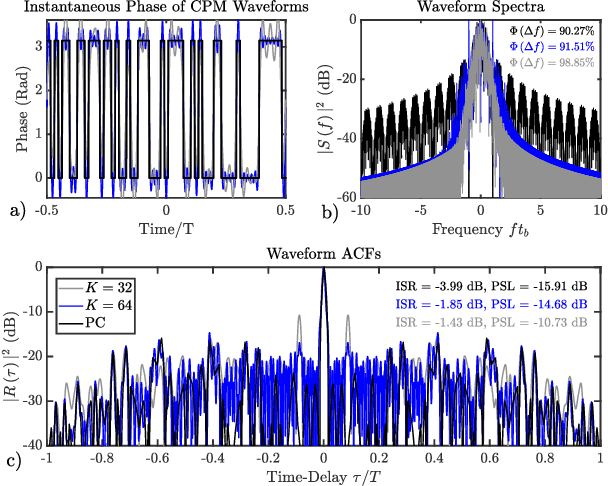
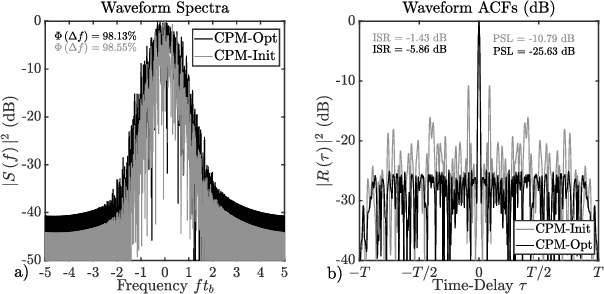
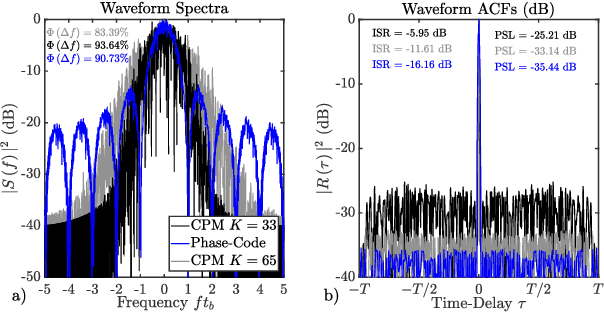
Abstract:Phase Coded (PC) waveforms possess desirable Auto-Correlation Function (ACF) properties for use in radar and sonar systems. However, their spectra possess high spectral leakage due to the abrupt phase transitions between the chips in the waveform. This paper describes a method of Continuous Phase Modulation (CPM) to reduce a PC waveform's spectral leakage using the Multi-Tone Sinusoidal Frequency Modulation (MTSFM) model. The MTSFM-CPM model represents the PC waveform's instantaneous phase as a finite Fourier series. This representation smooths the abrupt phase transitions between chips resulting in a spectrally compact waveform. This smoothing of the PC waveform's instantaneous phase introduces perturbations to the waveform's ACF mainlobe and sidelobe structure. Adjusting the MTSFM-CPM waveform's parameters refines its ACF mainlobe and sidelobe structure while also preserving its compact spectral shape.
Adaptive Transmit Waveform Design
Nov 16, 2021

Abstract:Recent research efforts in the Anti-Submarine Warfare (ASW) community have focused on developing sonar systems that adapt to their acoustic environment, referred to as "cognitive" sonars. Cognitive active sonar systems utilize principles of the perception action cycle of cognition to leverage information gathered from earlier sensing interactions with the underwater acoustic environment. This in turn informs the selection of system parameters to optimize target detection, classification, localization, and tracking performance in that acoustic environment. Of the many system parameters such a cognitive sonar system could potentially adapt, the acoustic signal transmitted into the medium, also known as the transmit waveform, has a profound impact on system performance. Many of the physical characteristics of the acoustic environment are contained in the return echo signal that is composed of amplitude scaled (target strength), time-delayed (target range) and Doppler shifted (target range-rate) echoes of the transmit waveform. This paper briefly describes a spectrally compact adaptive FM waveform model using Multi-Tone Sinusoidal Frequency Modulation (MTSFM). The MTSFM waveform's frequency and phase modulation functions are composed of a finite set of weighted sinusoidal harmonics. The weights for each harmonic are utilized as a discrete set of design coefficients. Adjusting these coefficients results in constant amplitude, spectrally compact FM waveforms with unique characteristics. The adaptability of the MTSFM combined with its transmitter friendly properties make it an attractive waveform type for a variety of active sonar applications and may provide a cognitive sonar system the ability to generate a complementary set of finely tuned waveforms for the novel scenarios and environments that it may encounter.
Exploring the Interdependencies Between Transmit Waveform Ambiguity Function Shape and Off-Axis Bearing Estimation
Jul 27, 2021



Abstract:The frequency dependent beampatterns of an active sonar projector filters the acoustic signal that is transmitted into the medium, also known as the transmit waveform. This filtering encodes information about the target's bearing relative to the main response axis. For any given projector and transmit waveform spectrum, there exists an optimal angle of operation which maximizes the Fisher Information (FI) of the target bearing estimate. Previous investigations into this phenomena show that for narrowband (i.e, high $Q$) Linear Frequency Modulated (LFM) waveforms, the angle of maximum FI is solely determined by its center frequency $f_c$. Steering the region of maximum bearing estimation precision is then achieved by appropriate selection of the LFM waveform's center frequency $f_c$. This fine bearing estimation is accomplished without steering the projector's main response axis. In addition to LFM waveforms, a wide variety of other active sonar waveform types exist that possess distinct spectral characteristics. These other waveforms possess different Ambiguity Function (AF) shapes from the LFM and are typically utilized to suite the range-Doppler resolution requirements of the active sonar system. This paper investigates the transmit waveform impact on off-axis bearing estimation performance and the spectral filtering impact on the waveform's AF shape. High $Q$ waveforms perform similarly to the LFM for off-axis bearing estimation while the transducer's spectral filtering perturbs the waveform's AF shape.
Matched Illumination Waveforms using Multi-Tone Sinusoidal Frequency Modulation
May 24, 2021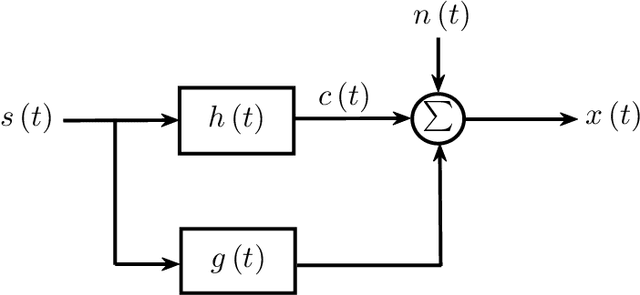
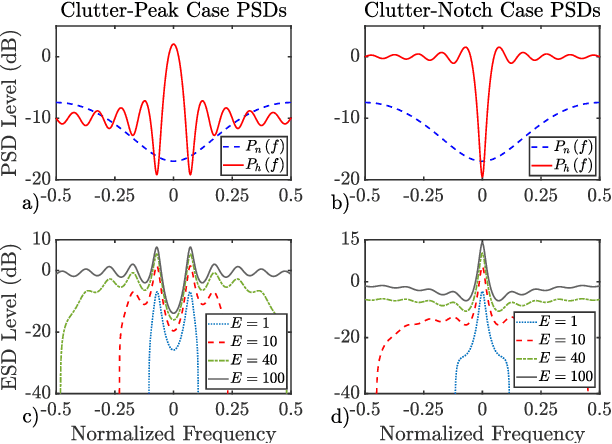
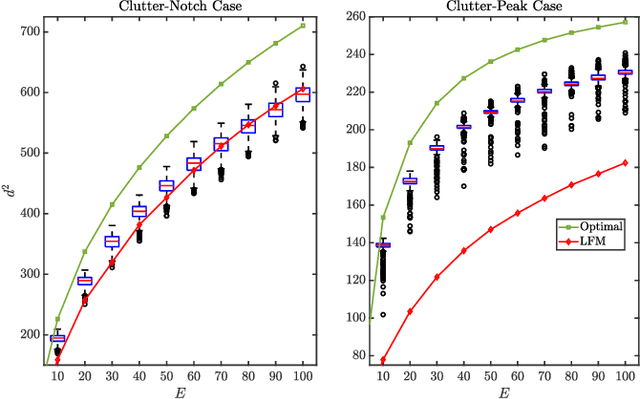
Abstract:This paper explores the design of constant modulus Matched-Illumination (MI) waveforms using the Multi-Tone Sinusoidal Frequency Modulation (MTSFM) waveform model. MI waveforms are optimized for detecting targets in known noise and clutter Power Spectral Densities (PSDs). There exist well-defined information theoretic methods that describe the design of MI waveforms for a myriad of target/noise/clutter models. However, these methods generally only produce the magnitude square of the MI waveform's spectrum. Additionally, the waveform's time-series is not guaranteed to be constant modulus. The MTSFM is a constant modulus waveform model with a discrete set of design coefficients. The coefficients are adjusted to synthesize constant modulus waveforms that approximate the ideal MI waveform's spectrum. Simulations demonstrate that the MTSFM's detection performance closely approximates an ideal MI waveform spectrum and generally outperforms flat spectrum waveforms across a range of transmit energies when the noise and clutter PSDs vary greatly across the operational band.
 Add to Chrome
Add to Chrome Add to Firefox
Add to Firefox Add to Edge
Add to Edge